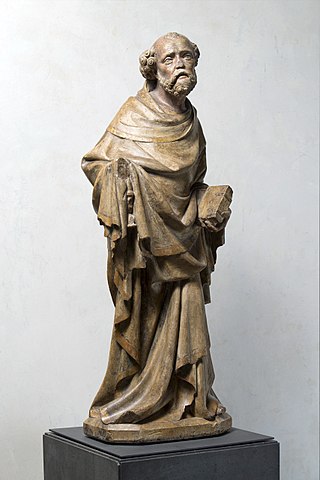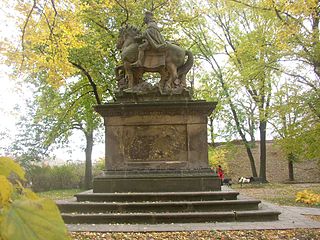
Wenceslaus I, Wenceslas I or Václav the Good was the Prince (kníže) of Bohemia from 921 until his death, probably in 935. According to the legend, he was assassinated by his younger brother, Boleslaus the Cruel.

Vyšehrad is a historic fort in Prague, Czech Republic, just over 3 km southeast of Prague Castle, on the east bank of the Vltava River. It was probably built in the 10th century. Inside the fort are the Basilica of St. Peter and St. Paul and the Vyšehrad Cemetery, containing the remains of many famous Czechs, such as Antonín Dvořák, Bedřich Smetana, Karel Čapek, and Alphonse Mucha. It also contains Prague's oldest Rotunda of St. Martin, from the 11th century.

Wenceslas Square is one of the main city squares and the centre of the business and cultural communities in the New Town of Prague, Czech Republic. Many historical events occurred there, and it is a traditional setting for demonstrations, celebrations, and other public gatherings. It is also the place with the busiest pedestrian traffic in the whole country. The square is named after Saint Wenceslas, the patron saint of Bohemia. It is part of the historic centre of Prague, a World Heritage Site.

The National Museum (NM) is a public museum dedicated to natural scientific and historical collections of the Czech Republic, its history, culture and people, among others. The museum was founded in 1818 by Kašpar Maria Šternberg. Historian František Palacký was also strongly involved in the foundation of the museum.

The crown of Saint Wenceslas is a crown forming part of the Bohemian crown jewels, made in 1346. Charles IV, king of Bohemia and Holy Roman Emperor, had it made for his coronation, dedicating it to the first patron saint of the country St. Wenceslas and bequeathed it as a state crown for the coronation of (future) Bohemian kings. On the orders of Charles IV the new royal crown was deposited in St. Vitus Cathedral, however, it was later transferred to Karlštejn Castle. It was used for the last time for the coronation of Ferdinand V in 1836.

The Church of the Mother of God before Týn, or Church of Our Lady before Týn, is a Gothic church and a dominant feature of the Old Town of Prague, Czech Republic. It has been the main church of this part of the city since the 14th century. The church's two towers are 80 m high, and each tower's spire is topped by eight smaller spires in two layers of four.

Johann-Georg Bendl, or Jan Jiří Bendl, was a Bohemian Baroque sculptor, who worked mainly in Prague.

Vojtěch Sucharda was a Czech sculptor, woodcarver and puppeteer.

Charles Square is a city square in the New Town of Prague, Czech Republic. At roughly 80,550 m² it is one of the largest squares in the world and was the largest town square of the medieval Europe. Founded in 1348 as the main square of the New Town by Charles IV, it was known as Dobytčí trh from the 15th century and finally named after its founder in 1848. The central portion of the square was turned into a park in the 1860s.

A lapidarium is a place where stone monuments and fragments of archaeological interest are exhibited.

The Church of the Most Sacred Heart of Our Lord is a Roman Catholic church at Jiřího z Poděbrad Square in Prague's Vinohrady district. It was built between 1929 and 1932 and designed by the Slovene architect Jože Plečnik. Plečnik found the inspiration for this construction in old Christian and ancient patterns. The Czech sculptor Damian Pešan (1887-1975) created statues of Christ and six Czech patron saints above the main altar, and he also designed the liturgical vessels.

The Treasury of St. Vitus Cathedral is a collection of ecclesiastical treasures of the Prague Cathedral and is in the property of Prague Cathedral Chapter. It is the largest church treasury in the Czech Republic and one of the most extensive in Europe. The Treasure contains more than 400 items, 139 from them have been displayed since 2012 in a new exhibition in the Chapel of the Holy Rood in Prague Castle.

The sculpture of St. Peter of Slivice comes from the Church of St. Peter in Slivice, founded by Jan of Jenštejn, Archbishop of Prague, in 1362. It ranks among early works by the "Master of the Krumlov Madonna" and is exhibited on loan at the permanent collection of the National Gallery in Prague.

The statue of Saint Wenceslas is an outdoor sculpture by Johann-Georg Bendl from 1680, installed at Vyšehrad, Prague, Czech Republic. The statue formerly stood in the middle of Wenceslas Square, near Grandhotel Evropa, but was moved to Vyšehrad in 1879.

The statues of Madonna, Saint Dominic and Thomas Aquinas are outdoor sculptures by Matěj Václav Jäckel, installed on the north side of the Charles Bridge in Prague, Czech Republic. Later, these statues were moved to the Lapidarium of the National Museum of the Czech Republic.

The following outline is provided as an overview of and topical guide to Prague:

The Marian column of Prague is a religious monument consisting of a column topped with a statue of the Virgin Mary, located in the city's Old Town Square. The original column was erected in 1650, shortly after the conclusion of the Thirty Years' War. It was demolished in November 1918, coinciding with the fall of Austria-Hungary. In 2020, the column was reconstructed, being completed on 15 August 2020.

Daniel Ignác Trubač is a Czech academic sculptor and medalist. He is best known for his sculpture of The Crown of St. Agnes of Bohemia, which was moved to St. Peter's Basilica in the Vatican City on request of Pope Francis.
























